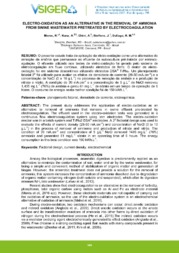Eletro-oxidation as an alternative in the removal of ammonia from swine wastewater pretreated by electrocoagulation.
Eletro-oxidation as an alternative in the removal of ammonia from swine wastewater pretreated by electrocoagulation.
Author(s): MORES, R.; KUNZ, A.; CHINI, A.; STEFFENS, J.; DALLAGO, R. M.
Summary: RESUMO: O presente estudo trata da aplicação da eletro-oxidação como uma alternativa de remoção da amônia que permanece no efluente da suinocultura pré-tratada por eletrocoagulação. O efluente utilizado nos testes de eletro-oxidação foi gerado pelo sistema de eletrocoagulação em fluxo contínuo, utilizando eletrodos de ferro. O reator de eletrooxidação foi em sistema descontínuo utilizando eletrodos DSA® Ti/Ru2. Um planejamento fatorial 2 2 foi utilizado para avaliar os efeitos da densidade de corrente (28-50 mA.cm-2 ) e a concentração de NaCl (0 a 10 g.L-1 ) no processo de remoção da amônia e a produção de nitrato e nitrito. A condição de 39 mA.cm-2 e a concentração de 5 g.L-1 de NaCl removeu 1,435 mg L-1 (76%) de amônia e gerou 61 mg L-1 de nitrato em um tempo de operação de 6 horas. O consumo de energia nesta melhor condição foi de 150 kWh.L-1 . ABSTRACT: The present study addresses the application of electro-oxidation as an alternative to removal of ammonia that remains in swine effluent pre-treated by electrocoagulation. The effluent used in the electro-oxidation tests was generated in a continuous flow electrocoagulation system using iron electrodes. The electro-oxidation reactor was in a batch system and Ti/Ru2 DSA® electrodes. A 22 factorial design was used to evaluate the effects of current density (28-50 mA.cm-2 ) and concentration of NaCl (0 to 10 g.L-1 ) in the process of removal of ammonia and production of nitrate and nitrite. The condition of 39 mA.cm-2 and concentration of 5 g.L-1 NaCl removed 1435 mg.L-1 (76%) ammonia and generated 61 mg.L-1 nitrate in an operating time of 6 hours. The energy consumption in this best condition was 150 kWh.L-1 .
Publication year: 2017
Types of publication: Paper in annals and proceedings
Unit: Embrapa Swine & Poultry
Keywords: Efluentes, Suinocultura, Águas residuais
Observation
Some of Embrapa's publications are published as ePub files. To read them, use or download one of the following free software options to your computer or mobile device. Android: Google Play Books; IOS: iBooks; Windows and Linux: Calibre.
Access other publications
Access the Agricultural Research Database (BDPA) to consult Embrapa's full library collection and records.
Visit Embrapa Bookstore to purchase books and other publications sold by Embrapa.

